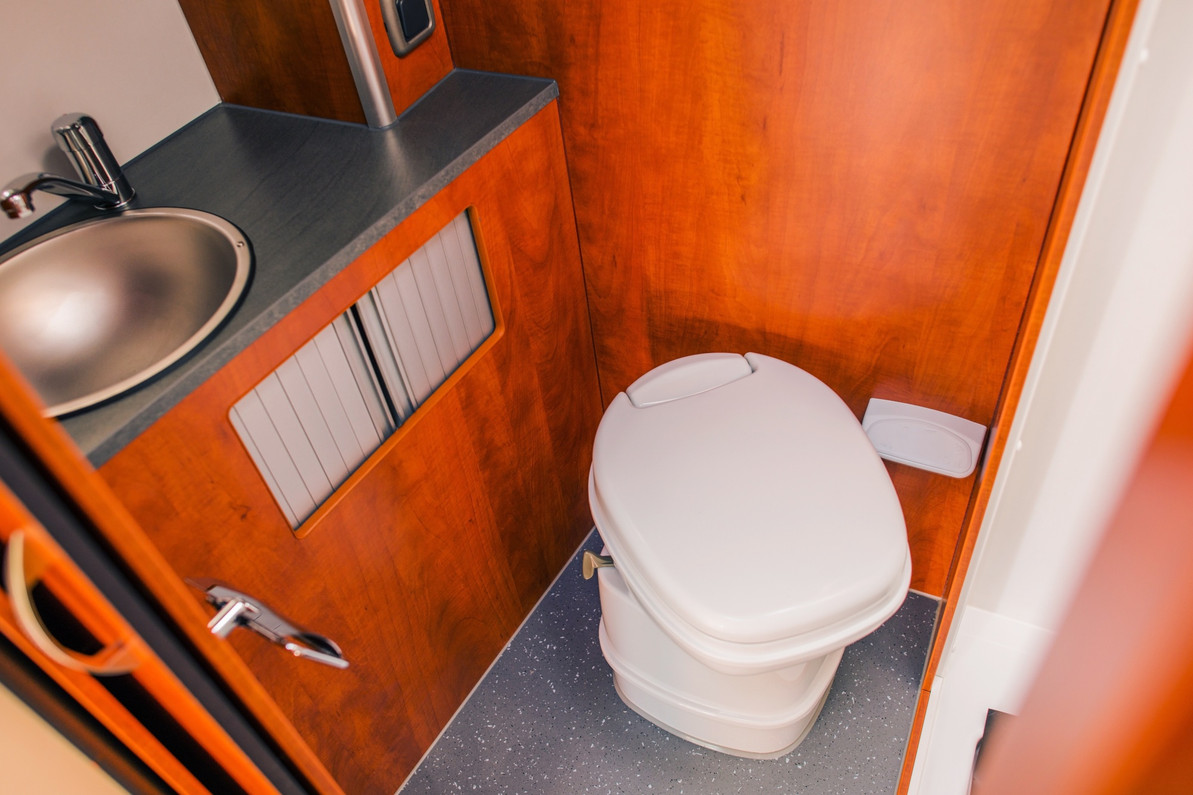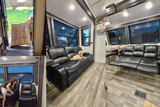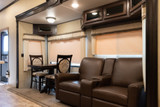Let's Talk Toilets
In RV camping, you are often faced with limited space and resources. From electrical systems to storage compartments, RVs are full of innovative ways to make the best use of what’s available. RV toilets are no different.
In this list, we will go through 8 different types of toilets that are compatible with RV living. There are many different options with varying pros and cons. In order to choose the best option for you, you will have to decide which features are most important and which features you are willing to sacrifice. To make that as easy as possible, we included a chart of pros and cons, which you can find at the end of this article.

Traditional Gravity Flush
Gravity-fed toilets are the most common type of toilet found in RVs and share the most resemblance to residential toilets found in homes. As the name implies, the flush system of this toilet relies primarily on gravity along with a small amount of pressurized water to clear the bowl between uses. Typically, these toilets are operated by a foot pedal, though automatic electrical flush options are becoming more available. Since this toilet must be positioned directly above the black tank, space configuration options with this style are limited.
space

Vacuum Flush
Vacuum flush toilets rely on suction to clear the bowl, which means they use very little water. Vacuum flush toilets are similar in comfort compared to a traditional toilets since they are very close in size and shape. Since waste is transported via a vacuum tube, this type of toilet does not need to be placed directly over the black tank in your RV.
space
 Cassette Toilet
Cassette Toilet
Cassette toilets are primarily found in smaller-sized travel trailers and camper vans. They are pretty similar in concept to portable toilets in that no electricity is used, and the holding tank is removable, allowing the contents to be quickly dumped when the tank is full. What separates a cassette toilet from a portable camping toilet is that the seat of a cassette toilet is permanently affixed inside of your camper, so only the holding tank is removable. In order to avoid carrying a full holding tank through your indoor living space, cassette toilet holding tanks are accessed from the outside of the vehicle via a side access panel.
space
Macerating Toilet
Macerating toilets, also called upflush toilets, work to remove waste through a macerating pump which manually grinds up waste and paper, similar to a garbage disposal. Maceration can prevent clogs and piles from forming in your black tank. Another nice feature of this toilet is that since it has an electric pump, it doesn’t need to be situated directly over your black tank.
space

Incinerating Toilet
Incinerating toilets get rid of waste by burning it until only a tiny amount of ash is left. No water is used in this process, only electricity (or, in some cases, natural gas or propane). The incineration process takes around one hour to complete, but the toilet is still usable during this time. Ventilation is required during incineration, so you will need a roof-top vent for smoke and fumes to escape safely. Since all biological waste is destroyed and fumes are vented outside your RV, incinerating toilets have very little to no odor. These toilets are on the higher end of the pricing spectrum for the initial purchase and also require a specialty liner for every use.
space
space
Dry Flush
A dry flush toilet is another waterless toilet option that can be used in RVs. If you are familiar with how a “Diaper Genie” works, these toilets rely on almost the exact same mechanism. In RVs, however, dry flush toilets are usually automatic and powered by electricity. In order to operate without water, these toilets use a plastic storage cartridge bag to wrap waste. The cartridges can simply be tossed in a trash bag and thrown in the garbage when they are full, so you never have to see or smell the waste, but the cost associated with the cartridges can be quite high - especially with multiple people using the toilet. You can expect each cartridge to last around 17 uses. Also, the cartridges are made from non-biodegradable plastic so if environmental impact is a significant concern for you, keep this in mind before choosing which toilet is best for you.
space

Composting Toilet
Composting toilets do not require water or electricity; instead, they use coconut coir or some other composting material to handle solid waste while liquid waste is disposed of separately. The design and mechanism of action for these toilets could best be described as “rustic” and will take some getting used to. In order to safely break down as compost, solid waste must be separated from liquid waste. This is accomplished via a diverting flap inside the bowl, which is operated by a handle on the side of the toilet during use. When the latch is closed, liquid waste will drain through a hole near the front of the bowl and run into a holding tank. Solid waste will drop into the compost bin when the latch is open. I told you this design takes some getting used to, but if energy and water conservation are top priorities for you, many people find that this type of toilet is worth it.
space

Portable Toilet
Portable toilets don’t provide many special features or intuitive designs, but they can always be there when you need them. Consisting of a toilet seat with a small holding tank, portable toilets are simple, hassle-free, and convenient. Relying on a portable toilet as the only toilet in an RV will likely not be very sustainable due to holding tank size and lack of waste treatment. However, having a portable toilet as a backup or in case of emergencies may be a smart idea.
space
| Toilet Type | Pros | Cons |
|
Traditional Gravity Flush |
|
|
| Vacuum Flush |
|
|
| Cassette Toilet |
|
|
|
Macerating Toilet |
|
|
| Incinerating Toilet |
|
|
| Dry Flush |
|
|
|
Composting Toilet |
|
|
| Portable Toilet |
|
|
What type of toilet do you have in your RV? What do you think of your current toilet? Did this article change your thoughts on which type of toilet may be best for you? Let’s talk toilets in the discussion box down below!
Recent Posts
-
Traveling to the RV Hall of Fame in Elkhart, IN
If you are traveling to Elkhart, IN to see the RV Hall of Fame, getting off the toll road at exit 96 …Nov 14, 2025 -
Best RV Air Conditioners of 2025: An Expert Guide From RecPro
Quick Answers Best overall RV air conditioner: RecPro 15K Quiet AC with Heat Pump (RP-AC3800) Best f …Oct 29, 2025 -
The Nuclear Nomads Expand Sofa with New Recliner Section Install
The Nuclear Nomads are a full time RV family living in south Florida. Andi and Joey value quality ti …Oct 24, 2025 -
Trailer Wiring Guide: How to Wire Your Trailer for Safety and Efficiency
Table of Contents 1. Common Types of Trailer Connectors 2. Trailer Wiring Diagrams: Color Codes and …Aug 20, 2024 -
How to Keep Your Pets Safe While Camping
RVing and camping are a great getaway from the hustle and bustle of work and the city and the day-to …Jul 02, 2024 -
Why Replace Your RV Furniture?
You may wonder when is the best time to replace your RV furniture. There is no one right answer to t …May 20, 2024







